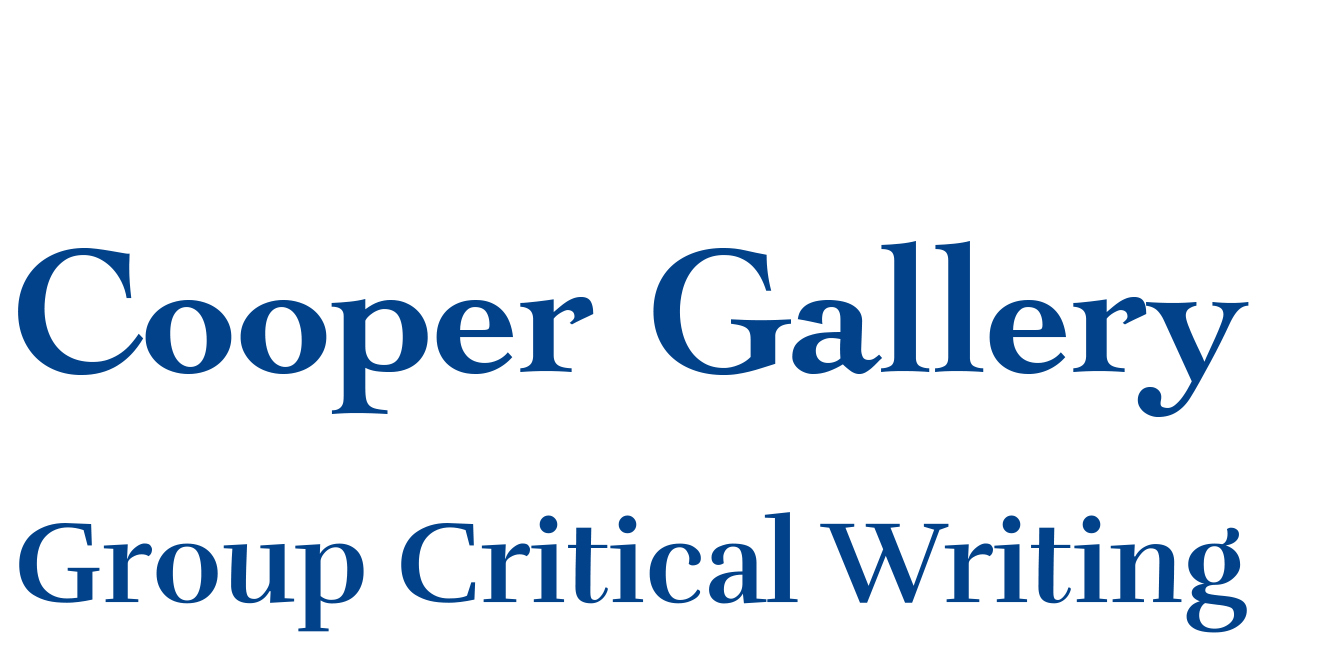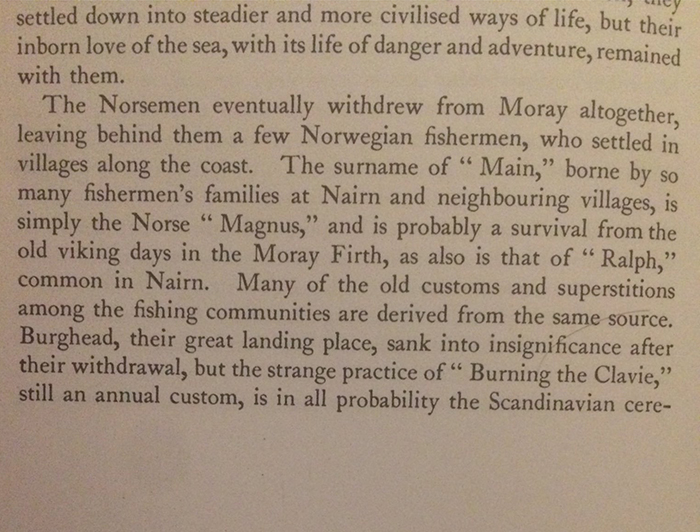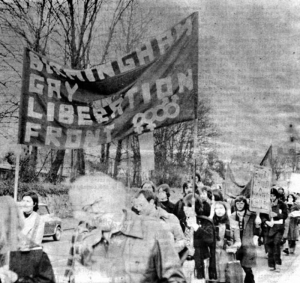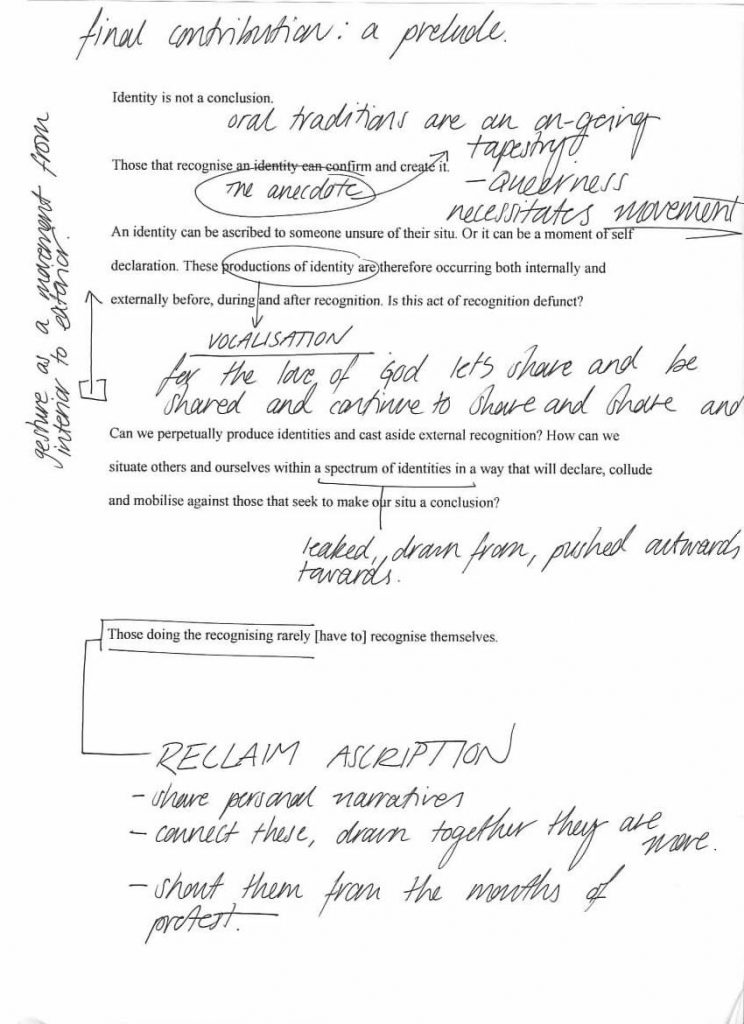Seán Elder
Seán Elder
Cooper Summer Residency 2017
Encountering [in difference]
♦
Identity is not a conclusion.
Those that recognise an identity can confirm and create it.
An identity can be ascribed to someone unsure of their situ. Or it can be a moment of self-declaration.
These productions of identity are therefore occurring both internally and externally before, during and after recognition.
Is this act of recognition defunct? Can we perpetually produce identities and cast aside external recognition?
How can we situate others and ourselves within a spectrum of identities in a way that will declare, collude and mobilise
against those that seek to make our situ a conclusion?
Those doing the recognising rarely [have to] recognise themselves.
Identity is not a conclusion.
♦
Gesture and its relationship to mobilisation. The space in between and what is spoken there.
♦
What have we been brought together by? Ourselves, or those that have made us ‘Them.’
♦
When legislation is brought closely to your body how do you react to the State?
♦
“Banners and declarations of proximity. Bodies marching and intent shared.”
Image courtesy: Birmingham Gay Liberation Front, 1974, Birmingham LGBT Archive Project
♦
20th September 2011.
Lady Gaga in long flowing blonde locks, glasses with managerial thick black flames, and a
killer suit.
“Good Afternoon”
Applause.
“Can you all hear me?”
More applause.
“My address to you today is called the Prime Rib of America.”
Following this, Gaga gives an impassioned speech in support of not just any troops, but
LGBT troops in the US armed forces. It ends [very nearly] with the following:
“If the senate and the President are not going to repeal this DADT policy then perhaps
they should be more clear with us about who the military is fighting for, who our tax
dollars are supporting*, and ultimately, how much does the prime rib cost? Because I
thought, this was an all-you-can-eat buffet?”
Heavy-handed metaphors aside, Gaga’s speech brought into proximity** two once-
disparate subjects with openness (Open-ness, here being the part that creates the
disparity). The Queer body and the military has a long and complex history. Historically
the Anglo-European armed forces were a point of acknowledged silence around acts of
‘buggery’, ‘sodomy’ or ‘perversion’***. With the people engaging in these acts not
necessarily always falling into the relatively new categories of Queer or Gay, they instead
belong to that of MSM (Men who have sex with Men). This historicity is situated firmly
within acts and sexual experiences – perhaps individual or several, but rarely to a point
where they might become part of a formative identity for those taking part in them. The
occasionality of these acts, and their distinction from individual identities point to a – degree
of – acceptance regarding physical acts of sex, but not the embedding of this within a larger
social framework of being.****
And so, if we imagine the distance between these two subjects – homo sex and the military
– we can see a space in-between them existing in this historical context. Or perhaps the space
exists between [homo]sexuality and the military rather than homosex.
The repeal of Don’t Ask Don’t Tell marked the closing of this gap (in a legal if not social
sense) between homosexuality and the military. A bringing-together of two bodies of
charged history and violence and illegality.
And yet despite all this dynamic imagery and context I could get into all I am reminded of is
an excerpt from Mark Haddon’s ‘A Spot of Bother’ which I read as a closeted 15 year old.
“Men sleeping together, I can imagine, on missions at sea or in space; to keep up morale, like
a good workout; handshake and shower afterwards. What disturbs me is the idea of men buying
furniture together.”
The acts and situ that Gaga refers to in her speech, lived experiences of those who love
those of the same gender, changed sexes or other’d identities, are instead fixed identities
predicated on not only the physical acts of sex and love but also the social understanding of
what a relationship is, and a desire to undertake that with someone of the same gender,
changed sexes or other’d identity. Similar to the Father-figure quoted above, Gaga is pre-
occupied with the domesticised homo. A domestic coupling predicated on monogamy, duty
to each-other and Nation. There is a relationship here between lived identities, the
domestic and the military which I am unsure of. There is a disregard for the lives of our
Black and Brown Queer brothers and sisters and siblings that comes with this acceptance of
militarisation – even a disregard for discussing it. Something about people “entering and
then pulling the drawbridge up after them”*****. Something about the embodiment of
nations as mothers. Something about protection. Something I am unsure of as of yet.
*A Queer Rights speech wouldn’t have taxes mentioned. A Gay one clearly does.
**[a phrase] to be followed on
***The History of Sexuality, Michel Foucault, 1976
****This of course differs those of sexual minorities from those of racial/intersectional minorities and our
ability to erase or mask parts of our identity when a necessity. There is a relationship between abstract and
concrete identities and how these terms fluctuate in relation to all aspects of Other’d identities, but I am
still unpicking this and imagine there is a lot to unpick.
***** I owe Lashana Charles-Queely this concise and evocative phrase.

Image: “In The Navy” Music Video, The Village People, (1979)
♦
“Co-ordinates to stay angry within and around.”
1. Lee Edelman’s No Future: Queer Futurity and the Death Drive [Thank you to artist
Gordon Douglas whose copy of this I still have in my bookcase] in which the writer argues
for the de-identification with a notion of futurity within the Queer political agenda.
2. José Esteban Muñoz’s Cruising Utopias: The Then and There of Queer Futurity [Thank you
to whoever recommended Muñoz’s writing to me, I can’t remember who you are but I owe
you thanks] in which the writer argues that a de-identification with a notion of futurity within
the Queer political agenda is unlikely regarded as an option to Queer People of Colour whose
moving towards a better future is sometimes all the fuel they have to keep battling.
3. Elke Krasny’s Curatorial Materialism: A Feminist Perspective on Independent and Co-Dependent
Curating in which the artist examines the curatorial turns roots in Feminist intervention and
anti-formalist approaches and how this might be tackled in the contemporary. This made me wonder
about the spectre of the curator as inherently gendered and the notion of authorship perhaps being
particularly volatile when we consider the high amount of male artists and female curators and how
this dynamic might operate.
4. “Édouard Glissant’s For Opacity becomes a means of understanding a strategy for survival, and
ambiguity as a means for facilitating knowledge production. This was something I hadn’t heard articulated
so clearly until Övül Durmuşoğlu discussed her own thoughts and processes of exhibition-making in a
recent Curatorial Curriculum session in Birmingham at Grand Union Gallery.
See also: Créolité – the process of creolising, two creating a new third, something that had been written
about (in relation to curating) to death by Hans-Ulrich Obrist.”
♦
Bringing into proximity
A few notes of what bringing into proximity calls to mind is detailed briefly below.
- Bodies, brought together by mutual intimacy.
[Hands, Mouths]
- Bodies, brought together by mutual animosity.
[Fists, Noses]
- Thoughts, brought together through speech and gesture.
[The speech, the lecture]
- Thoughts brought together through speech and gesture.
[Conversation, the anecdote]
- A practical act of positioning objects.
[The display, the arrangement, the exhibition]
Bringing works into proximity with one another is not the only gesture present within the wider act of curating.
To bring together is a physical occurrence* in this instance, but the before, during and after of this occurrence
is [read: can be] thoughtful.
Before ‘thoughtful’ I had two words written. They were very loaded words and so they have been retracted. I may
or may not decide to disclose what these words were at another point.
To position an act of curating as [redacted] or [redacted] seems both alienating and heavy-handed.
It is, however, thoughtful. The act of bringing things together must come with a desire to elicit shared or differing
qualities within these objects. To bring together two objects in the hopes of creating something new is dangerous
under the curator’s hand, and yet the bringing into proximity of two objects (or thoughts) can serve to further a
thought process for artist and viewer. It is an action that is rooted across many practices. The Museum brings
together and identifies and catalogues. A process seemingly straightforward that finds itself often occurring
chronologically and occasionally in museums happening conceptually or thematically.
This, like all gestures, can have varied degrees of success – one lacking in success that comes to mind is the
arrangement of ‘Warning Signs’ from both nature and man in Kelvingrove’s anthropological wings. A skunk and
a fire alarm, according to whoever manages their collection apparently sit together very comfortably.
If we are bringing these objects into proximity with one another then we are enabling those within the space
to create a conversation between the pieces of work of their own, not to insert or elicit a pre-existing conversation.
The dialogue these objects, things, brought close in space or thought to each-other will hopefully aid an existing
dialogue not too omni-present within its display, or create an entirely new one.
This phrase bringing into proximity, though indicative of a hand bringing together, also has made me think of ways
we might be approximated with others as a result of not individual hands or authorship, but the city, the state, the
nation, [the] society.
People are brought together by many things. And tracing the lines of reasoning can be tricky as these lines are often
faded, murky or tangled up in many others. Cruising for example can initially be seen as a being brought together by
mutual intimacy (1). But the landscape that created a setting for such intimacy was born of society’s dismissal of Queer
[mostly men’s] identities. And so, the proximities present within the widely historicised act of cruising include not only
those of Gay and Queer people’s bodies, but that of Queers and the Police. The Police in this instance being representative
of the State. And as the distances between White Gay men and the state narrows
(See here:
http://www.independent.co.uk/voices/theresa-may-marine-le-pen-homophobia-gay-voters-islamophobia-tim-farron-a7699196.html),
we need to understand that distance to one another is not the only hurdle to a cohesive and functioning group, mobilised
against state violence.
National legislation in this instance has a very real proximity to Queer bodies through the blunt force of a policeman’s baton.
♦
Early Queer Rights struggles were a heterotopia*.
Stonewall was a reaction to Police violence, not a desire for marriage ‘equality’ nor did it employ the now well-used tactics
of the current Gay rights movement’s ‘We’re not so different from you, we promise’ take on things. A Black Trans women
started the US Gay Rights movement. At the first Sydney Mardi Gras Aboriginal, Black, Brown and White participants
marched together.
As is so often noted by the Conservative press the acronym LGBTQIA is a long one. The diversity of people involved in
creating this struggle we call ‘Queer’ or more often than not, ‘Gay.’
*I might regret making such a declarative statement later. I am not a social theorist, nor am I an expert in Queer history.
But such strong statements at least make for a good opening line.
♦
A Glossary
Heterotopia
A space made of many diverse contributions and inhabiting’s.
Possibilities include:
– the exhibition
– the garden
– the society
Don’t Ask Don’t Tell
A policy which made it illegal to disclose non-heterosexual identity in various militaries (most prominently known is the
US policy, Department of Defense Directive 1304.26)
Stonewall
A riot that became the first protest for Queer rights in the USA. The incident happened in response to Police brutality
towards LGBTQIA when Black Trans* person Marsha P Johnson and other predominantly Black or Latinx Queers resisted
officers’ violence in New York City’s Greenwich Village.
Mardi Gras
Begun in honour of the Stonewall riots, the first Australian Gay Pride came about through trans-pacific discussions with
those organising similarly in San Francisco. The first Sydney Mardi Gras – known then in 1978 as The Day of International
Gay Solidarity – begun with a march of over 1000 people including Aboriginal Australians, Immigrants from the Italian,
Hispanic and Greek communities as well as Queers displaced from Australia’s rural communities.
Intimacy
To be in close proximity with another object, subject, knowledge or person.
Homonationalism
An association between ones sexual or gender identity and a (Usually Ethnic) Nationalist cause. Usually homosexual white
men voting for right wing candidates such as Donald Trump or Marine Le Pen under the false guise of fighting homophobia
within religious communities. See also: Pink washing and Israel’s occupation of Palestine.
Solidarity
An act with a degree of, but limited, use in the face of fascist adversity.
♦
Making a world through gesture.
The archival impulse is ubiquitous in Queer practices, surveys and theories.
Moments of gesture, cutting through the normative continuum of heteronormative space and time, so used to being
occupied neatly and appropriately, the process of world-making can only become evident from the position of looking back.
It is more difficult to ask
What world are we making?
than
What world did we make?
The notion that there is a Queer kind of cultural production naturally points to something lacking in normative modes
of making. This lack is not simply an absence in my mind. It is a very present non-existent. Lack indicates the suggestion
of something that should be present.
The moving towards making this something present is not always an act that happens with self-awareness. It may come
through necessity, belief or protest, and produce something that before it knows itself sits in opposition to
lack.
♦



